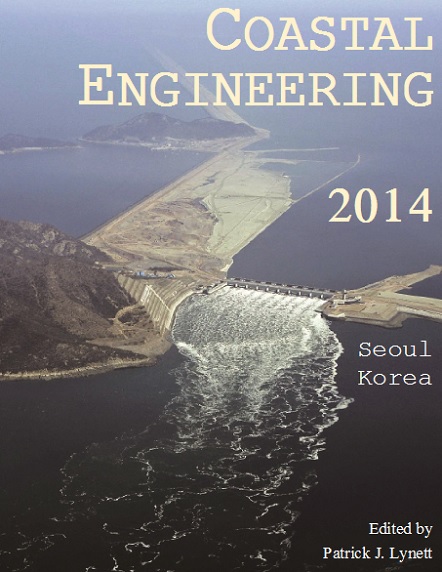Abstract
Strong wind blows around seawalls when wave overtopping disasters occur. Consequently, wind effects on wave overtopping are essential in designing seawalls. However, the relationship between wind and wave overtopping rate has not been clarified quantitatively because it is difficult to estimate the wind effects by hydraulic model experiments. The objective of this study was to introduce wind external force to a two-dimensional numerical model based on a numerical wave flume 'CADMAS-SURF'. A TimerDoor method, which was a computational method for the motion of water particles and air bubbles, was improved to represent wind-induced acceleration motion. The proposed method was validated through comparison with hydraulic model experiments. As a result, the dimensionless wave overtopping rates obtained by the numerical computations were in reasonable agreement with the experimental results. It was found that the proposed model is useful for wave overtopping simulation considering wind effects.References
Coastal Development Institute of Technology. 2001. Research and development on numerical wave flume (CADMAS-SURF) report on application of numerical wave flume to wave resistant design, Coastal Development Technology Library, No. 12, 457 p. (in Japanese).
Coastal Development Institute of Technology. 2008. Collection of actual CADMAS-SURF simulation examples- interim report on application of numerical wave tank to wave resistant design, Coastal Development Technology Library, No. 30, 368 p. (in Japanese).
Demirbilek, Z., S. M. Bratos, and E. F. Thompson. 1993. Wind products for use in coastal wave and surge models, U.S. Army Engineer Waterways Experiment Station, Coastal Engineering Research Center, Miscellameous Report CERC-93-7.
Donelan, M. A., B. K. Haus, N. Reul, W. J. Plant, M. Stiassnie, H. C. Graber, O. B. Brown and E. S. Saltzman. 2004. On the limiting aerodynamic roughness of the ocean in very strong winds, Geophys. Res. Lett., Vol. 31, L18306.
Drennan, W. M., K. K. Kahma, and M. A. Donelan. 1999. On momentum flux and velocity spectra over waves,
Boundary-Layer Meteorology, Vol. 92, 3, pp. 489-515.
Garratt, J. R. 1977. Review of drag coefficients over oceans and continents, Monthly Weather Review, Vol. 105, 7, pp. 915-929.
Geernaert, G.L. 1987.: On the importance of the drag coefficient in air-sea interactions, Dynamics of Atmospheres and Oceans, Vol. 11, 1, pp. 19-38.
Goda, Y. 2008. Wave resistant design of harbor and coastal structures, Kajima Institute Publishing Co., Ltd., pp. 430.
Honda, T. and H. Mitsuyasu. 1980. Experimental research of effect of wind on water surface, Proceedings of Coastal Engineering, JSCE, Vol. 27, pp. 90-93 (in Japanese).
Inoue, M., H. Shimada, and H. Enma. 1992. Wind effects on characteristics of wave overtopping over mild slope seawall, Proceedings of Coastal Engineering, JSCE, Vol. 39, pp. 586-590 (in Japanese).
Iwagaki, Y., M. Inoue, and K. Ohori. 1965. Studies on the effect of wind on wave overtopping on seawalls (second report), Proceedings of Coastal Engineering, JSCE, Vol. 12, pp. 168-192 (in Japanese).
Large, W. G. and S. Pond. 1981. Open ocean momentum flux measurements in moderate to strong winds, Journal of Physical Oceanography, Vol. 11, 3, pp. 324-336.
Moon, I. J., I. Ginis, T. Hara, and B. Thomas. 2007. A physics-based parameterization of air-sea momentum flux at high wind speeds and its impact on hurricane intensity predictions, Monthly Weather Review, Vol. 135, 8, pp. 2869-2878.
Nagai, S., and S. Ueda. 1960. Study on the shape and structure of seawall considering wind and waves, Proceedings of Coastal Engineering, JSCE, Vol, 7, pp. 245-273 (in Japanese).
Pullen, T., W. Allsop, T. Bruce, and J. Pearson. 2009. Field and laboratory measurements of mean overtopping discharges and spatial distributions at vertical seawalls, Coastal Engineering, Vol. 56, 2, pp. 121-140.
Reul, N., H. Branger, and J. P. Giovanangeli. 1999. Air flow separation over unsteady breaking waves, Physics of Fluids, Vol. 11, 7, pp. 1959-1961.
Smith, S. D. 1980. Wind stress and heat flux over the ocean in gale force winds, Journal of Physical Oceanography, Vol. 10, 5, pp. 709-726.
Smith, S. D. and E. G. Banke. 1975. Variation of the sea surface drag coefficient with wind speed, Q.J.R. Meteorol. Soc., Vol. 101, 429, pp. 665-673.
Takada, A. 1976. Wind effect on the overtopping discharges of regular waves, Proceedings of Coastal Engineering, JSCE, Vol. 23, pp. 170-175 (in Japanese).
Vickers, D. and L. Mahrt. 1997. Fetch limited drag coefficients, Boundary-Layer Meteorology, Vol. 85, 1, pp. 53-79.
Wu, J. 1980. Wind-stress coefficients over sea surface near neutral conditions -a revisit, Journal of Physical Oceanography, Vol. 10, 5, pp. 727-740.
Yamashiro, M., A. Yoshida, H. Hashimoto, N. Kurushima, and I. Irie. 2004. Conversion of the wind velocity in wave-overtopping experiment into the wind velocity of the real coast, Proceedings of Civil Engineering in the Ocean, JSCE, Vol. 20, pp. 653-658 (in Japanese).
Yelland, M. and P. K. Taylor. 1996. Wind stress measurements from the open ocean, Journal of Physical Oceanography, Vol. 26, 4, pp. 541-558.

